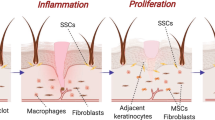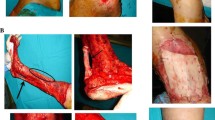Abstract
Background
Currently, acellular dermal substitutes used for skin reconstruction are usually covered with split-thickness skin grafts. The goal of this study was to develop an animal model in which such dermal substitutes can be tested under standardized conditions using a bioengineered dermo-epidermal skin graft for coverage.
Methods
Bioengineered grafts consisting of collagen type I hydrogels with incorporated human fibroblasts and human keratinocytes seeded on these gels were produced. Two different dermal substitutes, namely Matriderm®, and an acellular collagen type I hydrogel, were applied onto full-thickness skin wounds created on the back of immuno-incompetent rats. As control, no dermal substitute was used. As coverage for the dermal substitutes either the bioengineered grafts were used, or, as controls, human split-thickness skin or neonatal rat epidermis were used. Grafts were excised 21 days post-transplantation. Histology and immunofluorescence was performed to investigate survival, epidermis formation, and vascularization of the grafts.
Results
The bioengineered grafts survived on all tested dermal substitutes. Epidermis formation and vascularization were comparable to the controls.
Conclusion
We could successfully use human bioengineered grafts to test different dermal substitutes. This novel model can be used to investigate newly designed dermal substitutes in detail and in a standardized way.






Similar content being viewed by others
References
Schiestl C, Stiefel D, Meuli M (2010) Giant naevus, giant excision, eleg(i)ant closure? Reconstructive surgery with Integra artificial skin to treat giant congenital melanocytic naevi in children. J Plast Reconstr Aesthet Surg 63(4):610–615
Schiestl C, Neuhaus K, Biedermann T, Böttcher-Haberzeth S, Reichmann E, Meuli M (2011) Novel treatment for massive lower extremity avulsion injuries in children: slow, but effective with good cosmesis. Eur J Pediatr Surg 21(2):106–110
Stiefel D, Schiestl CM, Meuli M (2009) The positive effect of negative pressure: vacuum-assisted fixation of Integra artificial skin for reconstructive surgery. J Pediatr Surg 44(3):575–580
Stiefel D, Schiestl C, Meuli M (2010) Integra artificial skin for burn scar revision in adolescents and children. Burns 36(1):114–120
Böttcher-Haberzeth S, Biedermann T, Reichmann E (2010) Tissue engineering of skin. Burns 36(4):450–460
Heitland A, Piatkowski A, Noah EM, Pallua N (2004) Update on the use of collagen/glycosaminoglycate skin substitute-six years of experiences with artificial skin in 15 German burn centers. Burns 30(5):471–475
Branski LK, Herndon DN, Pereira C, Mlcak RP, Celis MM, Lee JO, Sanford AP, Norbury WB, Zhang XJ, Jeschke MG (2007) Longitudinal assessment of Integra in primary burn management: a randomized pediatric clinical trial. Crit Care Med 35(11):2615–2623
Schneider J, Biedermann T, Widmer D, Montano I, Meuli M, Reichmann E, Schiestl C (2009) Matriderm versus Integra: a comparative experimental study. Burns 35(1):51–57
Cervelli V, Lucarini L, Cerretani C, Spallone D, Palla L, Brinci L, De Angelis B (2010) The use of Matriderm and autologous skin grafting in the treatment of diabetic ulcers: a case report. Int Wound J 7(4):291–296
Böttcher-Haberzeth S, Biedermann T, Schiestl C, Hartmann-Fritsch F, Schneider J, Reichmann E, Meuli M (2012) Matriderm® 1 mm versus Integra® single layer 1.3 mm for one-step closure of full thickness skin defects: a comparative experimental study in rats. Pediatr Surg Int 28(2):171–177
Keck M, Haluza D, Lumenta DB, Burjak S, Eisenbock B, Kamolz LP, Frey M (2011) Construction of a multi-layer skin substitute: simultaneous cultivation of keratinocytes and preadipocytes on a dermal template. Burns 37(4):626–630
Haslik W, Kamolz LP, Nathschläger G, Andel H, Meissl G, Frey M (2007) First experiences with the collagen-elastin matrix Matriderm as a dermal substitute in severe burn injuries of the hand. Burns 33(3):364–368
Shakespeare PG (2005) The role of skin substitutes in the treatment of burn injuries. Clin Dermatol 23(4):413–418
Kearney JN (2001) Clinical evaluation of skin substitutes. Burns 27(5):545–551
Cervelli V, Brinci L, Spallone D, Tati E, Palla L, Lucarini L, De Angelis B (2011) The use of MatriDerm® and skin grafting in post-traumatic wounds. Int Wound J 8(4):400–405
Lamme EN, van Leeuwen RT, Mekkes JR, Middelkoop E (2002) Allogeneic fibroblasts in dermal substitutes induce inflammation and scar formation. Wound Repair Regen 10(3):152–160
Middelkoop E, van den Bogaerdt AJ, Lamme EN, Hoekstra MJ, Brandsma K, Ulrich MM (2004) Porcine wound models for skin substitution and burn treatment. Biomaterials 25(9):1559–1567
van den Bogaerdt AJ, Ulrich MM, van Galen MJ, Reijnen L, Verkerk M, Pieper J, Lamme EN, Middelkoop E (2004) Upside-down transfer of porcine keratinocytes from a porous, synthetic dressing to experimental full-thickness wounds. Wound Repair Regen 12(2):225–234
Philandrianos C, Andrac-Meyer L, Mordon S, Feuerstein JM, Sabatier F, Veran J, Magalon G, Casanova D (2012) Comparison of five dermal substitutes in full-thickness skin wound healing in a porcine model. Burns 38(6):820–829
Pontiggia L, Biedermann T, Meuli M, Widmer D, Böttcher-Haberzeth S, Schiestl C, Schneider J, Braziulis E, Montaño I, Meuli-Simmen C, Reichmann E (2009) Markers to evaluate the quality and self-renewing potential of engineered human skin substitutes in vitro and after transplantation. J Invest Dermatol 129(2):480–490
Costea DE, Loro LL, Dimba EA, Vintermyr OK, Johannessen AC (2003) Crucial effects of fibroblasts and keratinocyte growth factor on morphogenesis of reconstituted human oral epithelium. J Invest Dermatol 121(6):1479–1486
Braziulis E, Diezi M, Biedermann T, Pontiggia L, Schmucki M, Hartmann-Fritsch F, Luginbühl J, Schiestl C, Meuli M, Reichmann E (2012) Modified plastic compression of collagen hydrogels provides an ideal matrix for clinically applicable skin substitutes. Tissue Eng Part C Methods 18(6):464–474
Biedermann T, Pontiggia L, Böttcher-Haberzeth S, Tharakan S, Braziulis E, Schiestl C, Meuli M, Reichmann E (2010) Human eccrine sweat gland cells can reconstitute a stratified epidermis. J Invest Dermatol 130(8):1996–2009
Böttcher-Haberzeth S, Biedermann T, Pontiggia L, Braziulis E, Schiestl C, Hendriks B, Eichhoff OM, Widmer DS, Meuli-Simmen C, Meuli M, Reichmann E (2013) Human eccrine sweat gland cells turn into melanin-uptaking keratinocytes in dermo-epidermal skin substitutes. J Invest Dermatol 133(2):316–324
Meuli M, Raghunath M (1997) Burns (Part 2) tops and flops using cultured epithelial autografts in children. Pediatr Surg Int 12(7):471–477
Gobet R, Raghunath M, Altermatt S, Meuli-Simmen C, Benathan M, Dietl A, Meuli M (1997) Efficacy of cultured epithelial autografts in pediatric burns and reconstructive surgery. Surgery 121(6):654–661
Rheinwald JG, Green H (1975) Serial cultivation of strains of human epidermal keratinocytes: the formation of keratinizing colonies from single cells. Cell 6(3):331–343
Leary T, Jones PL, Appleby M, Blight A, Parkinson K, Stanley M (1992) Epidermal keratinocyte self-renewal is dependent upon dermal integrity. J Invest Dermatol 99(4):422–430
Botchkarev VA, Kishimoto J (2003) Molecular control of epithelial-mesenchymal interactions during hair follicle cycling. J Investig Dermatol Symp Proc 8(1):46–55
Schultz GS, Wysocki A (2009) Interactions between extracellular matrix and growth factors in wound healing. Wound Repair Regen 17(2):153–162
Helary C, Zarka M, Giraud-Guille MM (2012) Fibroblasts within concentrated collagen hydrogels favour chronic skin wound healing. J Tissue Eng Regen Med 6(3):225–237
Acknowledgments
This work was financially supported by the EU-FP6 project EuroSTEC (soft tissue engineering for congenital birth defects in children: contract: LSHB-CT-2006-037409), by the EU-FP7 project EuroSkinGraft (FP7/2007-2013: grant agreement no. 279024), and by the University of Zurich. We are particularly grateful to the Fondation Gaydoul and the sponsors of “Dona Tissue” (Thérèse Meier and Robert Zingg) for their financial support and interest in our work.
Conflict of interest
The authors declare that they have no conflict of interest.
Author information
Authors and Affiliations
Corresponding author
Additional information
F. Hartmann-Fritsch and T. Biedermann contributed equally to this paper.
Rights and permissions
About this article
Cite this article
Hartmann-Fritsch, F., Biedermann, T., Braziulis, E. et al. A new model for preclinical testing of dermal substitutes for human skin reconstruction. Pediatr Surg Int 29, 479–488 (2013). https://doi.org/10.1007/s00383-013-3267-y
Accepted:
Published:
Issue Date:
DOI: https://doi.org/10.1007/s00383-013-3267-y




